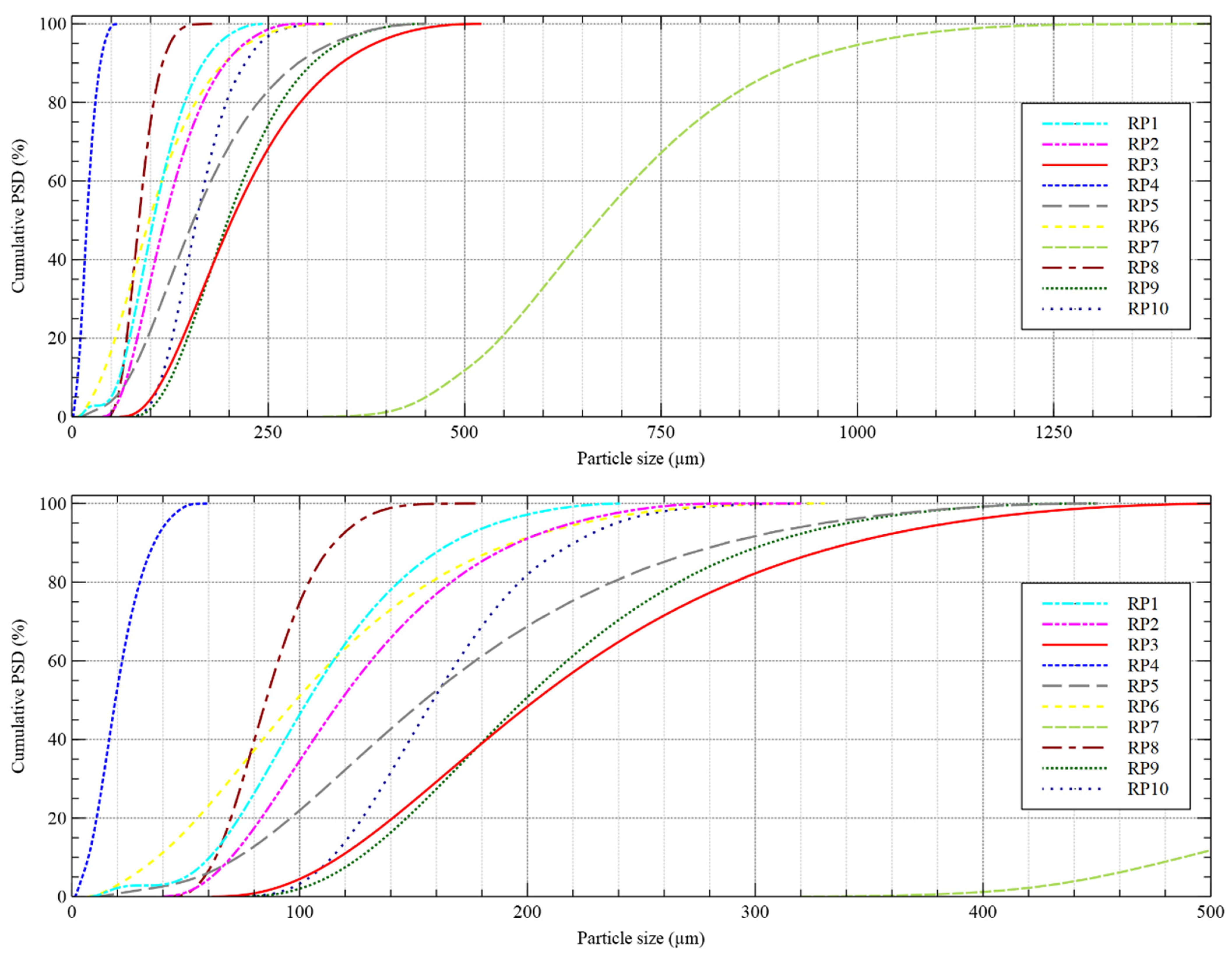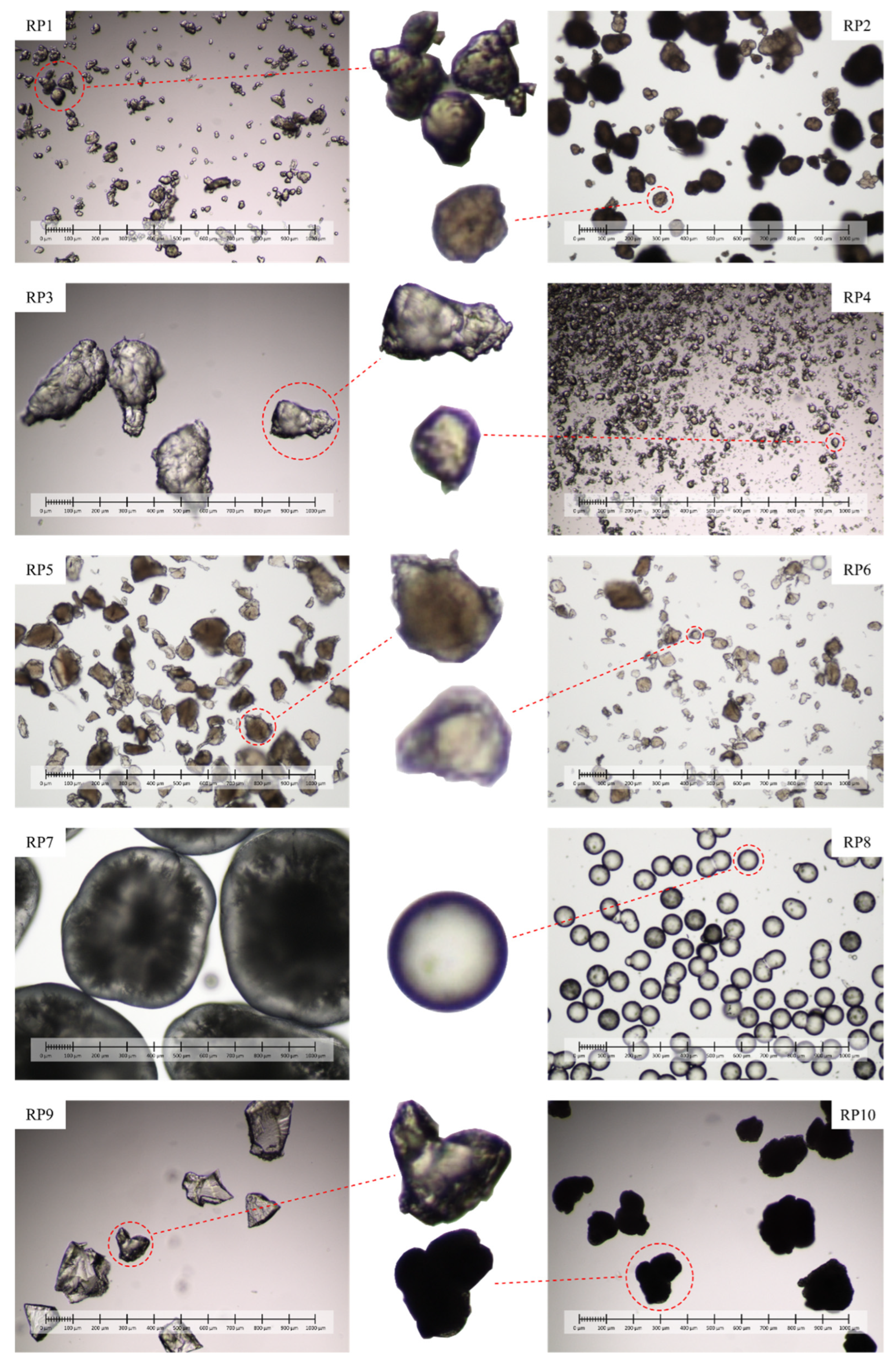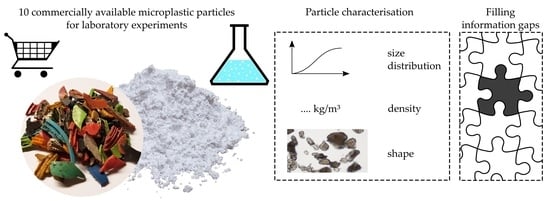Do We Speak the Same Language for Reference Particles in Microplastic Research?
Abstract
:1. Introduction
2. Materials and Methods
2.1. Material Selection and Characterization
2.2. Physical Particle Properties
3. Results and Discussion
3.1. Particle Density
3.2. Particle Size Distribution
3.3. Particle Shape
4. Conclusions
Supplementary Materials
Author Contributions
Funding
Institutional Review Board Statement
Informed Consent Statement
Data Availability Statement
Acknowledgments
Conflicts of Interest
References
- Mitrano, D.M.; Wohlleben, W. Microplastic regulation should be more precise to incentivize both innovation and environmental safety. Nat. Commun. 2020, 11, 5324. [Google Scholar] [CrossRef]
- Hartmann, N.B.; Huffer, T.; Thompson, R.C.; Hassellöv, M.; Verschoor, A.; Daugaard, A.E.; Rist, S.; Karlsson, T.; Brennholt, N.; Cole, M. Are We Speaking the Same Language? Recommendations for a Definition and Categorization Framework for Plastic Debris; ACS Publications: Washington, DC, USA, 2019. [Google Scholar]
- Shim, W.J.; Hong, S.H.; Eo, S.E. Identification Methods in Microplastic Analysis: A Review. Anal. Methods 2017, 9, 1384–1391. [Google Scholar] [CrossRef]
- Ahmed, M.B.; Rahman, M.S.; Alom, J.; Hasan, M.S.; Johir, M.A.H.; Mondal, M.I.H.; Lee, D.-Y.; Park, J.; Zhou, J.L.; Yoon, M.-H. Microplastic particles in the aquatic environment: A systematic review. Sci. Total Environ. 2021, 775, 145793. [Google Scholar] [CrossRef] [PubMed]
- Kowalski, N.; Reichardt, A.M.; Waniek, J.J. Sinking rates of microplastics and potential implications of their alteration by physical, biological, and chemical factors. Mar. Pollut. Bull. 2016, 109, 310–319. [Google Scholar] [CrossRef] [PubMed]
- Albertsson, A. Degradable Polymers, Recycling, and Plastics Waste Management; CRC Press: Boca Raton, FL, USA, 1995. [Google Scholar]
- Mason, S.A.; Garneau, D.; Sutton, R.; Chu, Y.; Ehmann, K.; Barnes, J.; Fink, P.; Papazissimos, D.; Rogers, D.L. Microplastic pollution is widely detected in US municipal wastewater treatment plant effluent. Environ. Pollut. 2016, 218, 1045–1054. [Google Scholar] [CrossRef] [PubMed]
- Mohamed Nor, N.H.; Kooi, M.; Diepens, N.J.; Koelmans, A.A. Lifetime accumulation of microplastic in children and adults. Environ. Sci. Technol. 2021, 55, 5084–5096. [Google Scholar] [CrossRef] [PubMed]
- Frias, J.; Nash, R. Microplastics: Finding a consensus on the definition. Mar. Pollut. Bull. 2019, 138, 145–147. [Google Scholar] [CrossRef] [PubMed]
- Connors, K.A.; Dyer, S.D.; Belanger, S.E. Advancing the quality of environmental microplastic research. Environ. Toxicol. Chem. 2017, 36, 1697–1703. [Google Scholar] [CrossRef] [PubMed]
- da Costa, J.P.; Reis, V.; Paço, A.; Costa, M.; Duarte, A.C.; Rocha-Santos, T. Micro (nano) plastics—Analytical challenges towards risk evaluation. TrAC Trends Anal. Chem. 2019, 111, 173–184. [Google Scholar] [CrossRef]
- Potthoff, A.; Oelschlägel, K.; Schmitt-Jansen, M.; Rummel, C.D.; Kühnel, D. From the sea to the laboratory: Characterization of microplastic as prerequisite for the assessment of ecotoxicological impact. Integr. Environ. Assess. Manag. 2017, 13, 500–504. [Google Scholar] [CrossRef] [PubMed]
- Seghers, J.; Stefaniak, E.A.; La Spina, R.; Cella, C.; Mehn, D.; Gilliland, D.; Held, A.; Jacobsson, U.; Emteborg, H. Preparation of a reference material for microplastics in water—Evaluation of homogeneity. Anal. Bioanal. Chem. 2022, 414, 385–397. [Google Scholar] [CrossRef] [PubMed]
- Ogonowski, M.; Gerdes, Z.; Gorokhova, E. What we know and what we think we know about microplastic effects—A critical perspective. Curr. Opin. Environ. Sci. Health 2018, 1, 41–46. [Google Scholar] [CrossRef]
- Rochman, C.M.; Brookson, C.; Bikker, J.; Djuric, N.; Earn, A.; Bucci, K.; Athey, S.; Huntington, A.; McIlwraith, H.; Munno, K. Rethinking microplastics as a diverse contaminant suite. Environ. Toxicol. Chem. 2019, 38, 703–711. [Google Scholar] [CrossRef] [PubMed] [Green Version]
- Rosal, R. Morphological description of microplastic particles for environmental fate studies. Mar. Pollut. Bull. 2021, 171, 112716. [Google Scholar] [CrossRef] [PubMed]


| Name | Type | Product Name | Manufacturer | Density (kg/m3) | Size (µm) | Price Range (USD/kg) | Order Quantity (kg) |
|---|---|---|---|---|---|---|---|
| RP1 | HDPE | Rowalit N100-20 | ROWAK AG | 956 | 0–120 * | 101–300 | 0.5 |
| RP2 | HDPE | ET306010 | GOODFELLOW CORP. | 940 | 150 ** | 301–500 | 0.5 |
| RP3 | LDPE | Rowalit H70 | ROWAK AG | 918 | 0–200 * | 101–300 | 0.5 |
| RP4 | PA | Vestosint 2158 | EVONIK INDUSTRIES AG | 1016 | 21 ** | 0–100 | 20 |
| RP5 | PET | ES306030 | GOODFELLOW CORP. | 1300–1400 | <300 *** | 301–500 | 0.5 |
| RP6 | PET | ES306031 | GOODFELLOW CORP. | 1300–1400 | <300 *** | 301–500 | 0.5 |
| RP7 | PP | Eltex P KS001PF | INEOS OLEFINS & POLYMERS EUROPE | 895 | 600 ** | - | 25 |
| RP8 | PS | PrimeCast 101 | EOS GMBH | 700–850 | 80 ** | 0–100 | 2 |
| RP9 | PUR | Rowalit 500-9H | ROWAK AG | 1190 | 0–90 * | 101–300 | 0.5 |
| RP10 | PVC | CV316010 | GOODFELLOW CORP. | 1400 | <250 | 101–300 | 2 |
| Name | Type | Density (kg/m3) | Particle Size Distribution (µm) | Shape * | ||||
|---|---|---|---|---|---|---|---|---|
| Dmin | D10 | D50 | D90 | Dmax | ||||
| RP1 | HDPE | 951 | 9 | 61 | 104 | 167 | 241 | Irregular particles |
| RP2 | HDPE | 950 | 40 | 70 | 118 | 196 | 320 | Irregular particles |
| RP3 | LDPE | 916 | 62 | 117 | 203 | 343 | 520 | Irregular particles |
| RP4 | PA | 1059 | 1 | 7 | 19.1 | 36 | 60 | Irregular particles |
| RP5 | PET | 1402 | 10 | 73 | 155 | 288 | 450 | Irregular particles |
| RP6 | PET | 1409 | 7 | 38 | 98 | 194 | 330 | Irregular particles |
| RP7 | PP | 882 | 320 | 488 | 670 | 921 | 1450 | Irregular particles |
| RP8 | PS | 1069 | 40 | 63 | 85 | 115 | 177 | Spheres |
| RP9 | PUT | 1218 | 71 | 126 | 199 | 307 | 450 | Irregular particles |
| RP10 | PVC | 1414 | 72 | 114 | 159 | 221 | 325 | Irregular particles |
| Polynom * | R2 | RMSE |
|---|---|---|
| 0.9282 | 10.17 | |
| 0.9882 | 4.146 | |
| 0.9928 | 3.206 | |
| 0.9991 | 1.184 | |
| 1.000 | 0.220 | |
| 1.000 | 0.184 |
| Name | Average Particle Density (kg/m3) | Number of Measurements (−) | Standard Deviation (kg/m3) | Var. Coefficient (%) |
|---|---|---|---|---|
| RP1 | 951 | 7 | 0.1 | 0.0089 |
| RP2 | 949.7 | 10 | 0.2 | 0.0209 |
| RP3 | 915.5 | 9 | 0 | 0.0050 |
| RP4 | 1058.5 | 12 | 0 | 0.0047 |
| RP5 | 1401.6 | 10 | 0.3 | 0.0180 |
| RP6 | 1408.7 | 10 | 0.5 | 0.0323 |
| RP7 | 881.9 | 10 | 0.9 | 0.1025 |
| RP8 | 1068.7 | 10 | 0.4 | 0.0407 |
| RP9 | 1218.4 | 10 | 0.1 | 0.0099 |
| RP10 | 1413.8 | 12 | 0.4 | 0.0303 |
Publisher’s Note: MDPI stays neutral with regard to jurisdictional claims in published maps and institutional affiliations. |
© 2022 by the authors. Licensee MDPI, Basel, Switzerland. This article is an open access article distributed under the terms and conditions of the Creative Commons Attribution (CC BY) license (https://creativecommons.org/licenses/by/4.0/).
Share and Cite
Senfter, T.; Walter, A.; Dür, L.; Alber, F.; Pillei, M. Do We Speak the Same Language for Reference Particles in Microplastic Research? Microplastics 2022, 1, 221-228. https://doi.org/10.3390/microplastics1010015
Senfter T, Walter A, Dür L, Alber F, Pillei M. Do We Speak the Same Language for Reference Particles in Microplastic Research? Microplastics. 2022; 1(1):221-228. https://doi.org/10.3390/microplastics1010015
Chicago/Turabian StyleSenfter, Thomas, Andreas Walter, Lukas Dür, Florian Alber, and Martin Pillei. 2022. "Do We Speak the Same Language for Reference Particles in Microplastic Research?" Microplastics 1, no. 1: 221-228. https://doi.org/10.3390/microplastics1010015
APA StyleSenfter, T., Walter, A., Dür, L., Alber, F., & Pillei, M. (2022). Do We Speak the Same Language for Reference Particles in Microplastic Research? Microplastics, 1(1), 221-228. https://doi.org/10.3390/microplastics1010015







